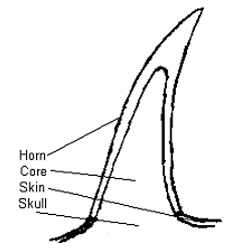Sources of Horn
Abbeyhorn makes use of a variety of natural materials to bring you our extensive collection of items. Our raw supplies are sourced ethically from renewable resources, often recycling a ’waste’ product from the meat industry and as a result preventing it from ending up in landfill. The majority of our finished products are biodegradable and/or recyclable, making a truly ecological product.
Here we will try to explain what each material is and where it comes from:
Cow Horn
(Also refered to as Oxhorn, Ox Horn, Horn, Ankole Cattle Horn)
Latin Name: Bos Indicus
Source: West Africa
Our domestic cattle, here in the UK, have been selectively bred so they no longer grow horns, this has been done to prevent the cattle from harming one another and consequently damaging the product they are reared for e.g. hide or meat.
Abbeyhorn therefore uses horn from Ankole Cattle sourced as a by-product of the meat industry in Nigeria. With more space to roam their horns are left to grow, producing the very large, distinctive horns with both great length and circumference that are ideal for use in hornworking.
Description:
Horns are the pointed projections, from the forehead of animals such as bison, sheep, goats and cattle, they start to grow soon after birth and continue to grow throughout the life of the animal. Unlike members of the deer family both the male and the female have horns.
Horn consists of two distinct parts: a short inner core of living bone and an outer covering of horn. This outer covering is made of keratin (the same material as our nails and hair) and is more or less hollow except for the very tip.
Cow horn has thermoplastic properties, which means it can be softened and made malleable by heating. It can then be bent, shaped and moulded into various contours to create the wonderful horn products in our range. Un-worked cattle horn has a rough dull surface, however after sanding and polishing the horn takes on a smooth glossy appearance, it is only at this stage that it’s true colours appear. While cattle horn can be nearly any colour, it is generally a light creamy colour, sometimes streaked with white, brown or black patches; take a look at a few of our images to see the range of colours that can be found.
NB. No two pieces will ever be the same and the colours you receive will vary from those pictured.


Antler
Latin Name: Cervus Elaphus Scotticus
Source: Scotland
Abbeyhorn uses Antler from Scottish Red Deer, which is one of the largest of the deer species in the UK. It is sourced as a natural by-product of the Scottish deer farming industry.
Only the stags have antlers, which start growing in the spring and are shed each year, usually at the end of winter, as part of their natural life cycle.
Description:
An antler is an appendage of the skull of animals such as deer, elk, moose and caribou. Antlers are temporary, often branched structures made of a specialised form of bone, supported on a permanent bony core with a skin-covered base. The outer layer of antler is very dense whilst the inner core is honeycombed.
Antler growth is dependent on diet and is not, as is often believed, an indication of age - they can grow at a rate of 2.5 cm a day. During growth they are nourished by a furry skin, called velvet, which also acts as a protective device against antler damage, since it is very sensitive, deer are careful not to bump antlers when in velvet.
The velvet is shed in the autumn after the antlers are fully-grown, then the antler begins to calcify as the stags approach the rut (mating season). In winter, following the rut, the antlers are shed and new growth begins in the following spring.
Antler often has a rough textured surface and is usually a dark brown colour but can range from light brown through to creamy white.
It is thought the colouring depends on diet and climate; take a look at a few of our images to see the range of colours that can be found.
NB. No two pieces will ever be the same and the colours you receive will vary from those pictured.


Cow Bone
Latin Name: Bos Indicus
Source: China
Abbeyhorn uses the shinbone of domestic cattle sourced as a by-product of the Chinese meat industry. The bone is already cleaned, bleached and processed before we purchase it.
Description:
Bones are the rigid organs that form part of the skeleton of all vertebrates and are composed mainly of Calcium Carbonate. They serve to move, support, and protect the various organs of the body.
Bone is not a uniformly solid material, but has a honeycombed internal structure, this gives it it’s rigidity making it lightweight, yet strong and hard. The hard outer layer of the bone is composed of compact bone tissue, also referred to as dense bone, so-called due to its minimal gaps and spaces. Only the very densest shinbone is used which has the thickest hard outer layer.
Bone looks similar to ivory but it is lighter in weight and usually not as white. A polished bone surface usually has small pits and what appears to be a lightly scratched surface; these are the exposed "tunnels" that permeate the bone.
The soft flowing lines and smooth milky white appearance of a bone spoon is only the start, it is soft and warm to the touch and is more resilient and durable than horn. Over a period of time bone absorbs oils from your skin and changes colour to a very light honey gold.

Deer Bone
Latin Name: Cervus Elaphus Scotticus
Source: Scotland
Like antler, Abbeyhorn uses bone from Scottish Red Deer, one of the largest of the deer species. It is sourced as a natural by-product of the Scottish deer farming industry.
Unlike the Chinese bone it has been unprocessed and still contains the fatty marrow, which is essential for using in leatherwork.

Buffalo Horn
Latin Name: Bubalus Bubalis
Source: India
Water Buffalo horns come mostly from India and Thailand. These horns are from the Asian buffalo, bred for domestic purposes and are widely used because the animal is not a protected species unlike its African counterpart.
Description:
Buffalo horn is made up of dense layers of fibres that have a very hard and durable surface, it resembles Cattle Horn greatly in its structure, however the walls are much thicker and more of the tip is solid.
Buffalo horn is nearly always entirely black and quite heavily ridged along the inner side curve; it is flatter and far more rectangular than cow horn. When given a high polish buffalo horn develops an extremely hard surface and has to be one of the toughest natural materials.
Abbeyhorn uses buffalo in only a few of its products, but as we are often asked for raw pieces, we do hold a small stock suitable for such things as door handles, gun butts and umbrella handles.


Rams Horn
Latin Name: Ovis Aries
Source: Cumbria
Abbeyhorn sources its Ramshorn locally as a by-product of the Cumbrian meat industry. The horn comes from mature Swaledale Rams, but other breeds such as Herdwick’s, Cheviots and Portland’s are sometimes used.
Description:
Rams horn is similar in structure to cow horn in that it contains a central bony core that continues to grow upward and outward from the base of the skull. The central core may extend in a taper for up to one third of the internal length of the horn.
An outer layer of keratin surrounds the core and, whilst on young rams it may be less than 3mm thick at the base, in older rams it can be up to 15mm. The shape of the horn is helical narrowing towards its tip; in cross-section it is almost a triangle.
Rams horn is usually a creamy yellow colour but occasionally can have black streaks or on rare occasions can be nearly completely black. Un-worked Ramshorn has a dull, ridged surface but once worked takes on a smooth glass like appearance.
Our Ramshorn is purchased to make some of the walking sticks in our range but we stock ample raw material for craftsmen who wish to dress their own sticks, make buttons, shofarot or bows.


Secure Online Payment
© 2025 Abbeyhorn

